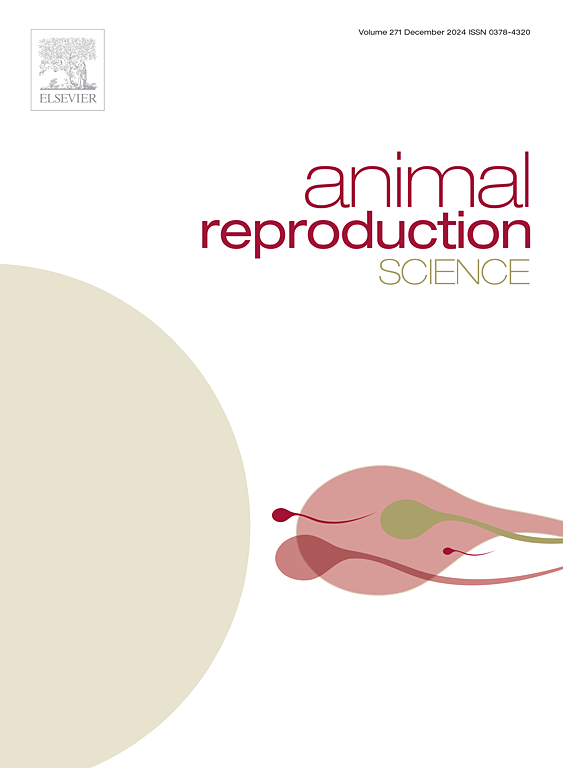Cryopreservation of in vivo derived goat embryos: Influence of post-collection incubation methods on cellular stress and survival rates
IF 3.3
2区 农林科学
Q1 AGRICULTURE, DAIRY & ANIMAL SCIENCE
引用次数: 0
Abstract
This study evaluated how post-collection conditions affect the survival of in vivo-derived (IVD) goat embryos after cryopreservation. A total of 223 IVD embryos (grades I and II) from three replicates were distributed into three groups: P0–3H, embryos maintained for 3 h at 37 °C in culture dishes with 2 mL of holding medium (HM); P6–8H, embryos held under the same conditions for 6–8 h; and T6–8H, embryos stored in cryotubes with 2 mL of HM at 37 °C for 6–8 h in a portable incubator. Osmolarity analysis showed increases of 15.3 % ± 3.4 and 48.8 % ± 8.5 in P0–3H and P6–8H, respectively, while T6–8H maintained osmotic stability (1.0 % ± 1.4). Developmental outcomes were better in T6–8H, with higher proportions of blastocysts and expanded blastocysts (27.5 %± 2.7 and 42.5 % ± 3.2) compared to P6–8H (14.1 % ± 1.4 and 34.6 % ± 3.0). However, post-thaw survival rates were similar across groups (P > 0.05). Gene expression analysis revealed increased stress (PRDX1, HSP70) and apoptosis (BAX) markers in P6–8H compared to T6–8H. The highest mitochondrial activity and ROS levels were observed in T6–8H, whereas GSH levels were elevated in P6–8H, matching P0–3H values. These findings suggest that the T6–8H condition—embryos stored in cryotubes with HM at 37 °C—preserved osmotic balance, supported better embryo development, and promoted a more favorable cellular environment. Therefore, this strategy may improve embryo quality before cryopreservation, contributing to more consistent post-thaw outcomes in goat embryo transfer programs.
山羊体外胚胎的低温保存:收集后孵育方法对细胞应激和存活率的影响
本研究评估了收集后的条件如何影响体外来源(IVD)山羊胚胎冷冻保存后的存活率。将3个重复的223个IVD胚胎(I级和II级)分为3组:p - 3h组,胚胎在37℃培养皿中保存3 h,培养基为2 mL (HM);P6-8H,相同条件下胚胎保存6-8 h;T6-8H,胚胎在冷冻管中加入2 mL HM,在便携式培养箱中,37℃保存6-8 h。渗透压分析显示,P0-3H和P6-8H分别增加15.3 %±3.4和48.8 %±8.5,而T6-8H保持渗透稳定性(1.0 %±1.4)。T6-8H发育情况较好,囊胚和膨大囊胚比例(27.5% %±2.7和42.5 %±3.2)高于P6-8H(14.1 %±1.4和34.6 %±3.0)。但各组解冻后存活率相似(P >; 0.05)。基因表达分析显示,与T6-8H相比,P6-8H的应激(PRDX1、HSP70)和凋亡(BAX)标志物增加。线粒体活性和ROS水平在T6-8H时最高,而GSH水平在P6-8H时升高,与P0-3H值一致。这些结果表明,T6-8H条件下的胚胎在37°c的低温下保存,保持了渗透平衡,支持了胚胎更好的发育,促进了更有利的细胞环境。因此,这种策略可以提高冷冻保存前的胚胎质量,有助于山羊胚胎移植项目中更一致的解冻后结果。
本文章由计算机程序翻译,如有差异,请以英文原文为准。
求助全文
约1分钟内获得全文
求助全文
来源期刊

Animal Reproduction Science
农林科学-奶制品与动物科学
CiteScore
4.50
自引率
9.10%
发文量
136
审稿时长
54 days
期刊介绍:
Animal Reproduction Science publishes results from studies relating to reproduction and fertility in animals. This includes both fundamental research and applied studies, including management practices that increase our understanding of the biology and manipulation of reproduction. Manuscripts should go into depth in the mechanisms involved in the research reported, rather than a give a mere description of findings. The focus is on animals that are useful to humans including food- and fibre-producing; companion/recreational; captive; and endangered species including zoo animals, but excluding laboratory animals unless the results of the study provide new information that impacts the basic understanding of the biology or manipulation of reproduction.
The journal''s scope includes the study of reproductive physiology and endocrinology, reproductive cycles, natural and artificial control of reproduction, preservation and use of gametes and embryos, pregnancy and parturition, infertility and sterility, diagnostic and therapeutic techniques.
The Editorial Board of Animal Reproduction Science has decided not to publish papers in which there is an exclusive examination of the in vitro development of oocytes and embryos; however, there will be consideration of papers that include in vitro studies where the source of the oocytes and/or development of the embryos beyond the blastocyst stage is part of the experimental design.
 求助内容:
求助内容: 应助结果提醒方式:
应助结果提醒方式:


